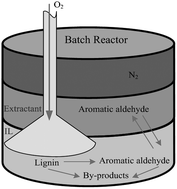Process of lignin oxidation in an ionic liquid coupled with separation†
Abstract
A novel approach has been developed in order to use lignin as a renewable resource for the production of a high added-value aromatic aldehyde. The concept is based on the use of an ionic liquid as a reversible medium coupled with the separation process, which prevents the aromatic aldehyde products from oxidizing and increases their yields. The conversion of lignin reached 100%, and the total yield of the aromatic aldehydes (vanillin, syringaldehyde and p-hydroxybenzaldehyde) was 29.7% in the coupled process. In addition, the mixture of product and IL phase was easily separated, and the IL phase demonstrated good reusability. Hence, a clean and environmentally friendly strategy for overall utilization of lignin and preparation of an aromatic aldehyde is developed.


 Please wait while we load your content...
Please wait while we load your content...